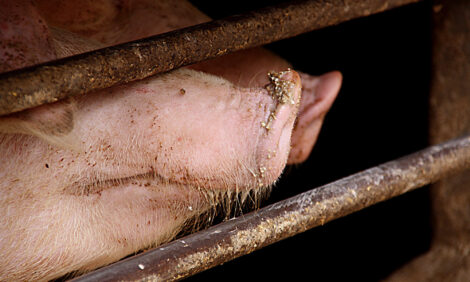



ASF threat: Three US swine vets share insights from the frontline
The rapid spread of African swine fever (ASF) throughout China and other regions of the world has raised concerns the disease will ultimately make its way to the US — a development that could cripple the nation’s pork industry if it doesn’t adequately prepare.That was the ominous warning of three US swine veterinarians who came together for a roundtable discussion on ASF following their recent trip to China.
The informative session was organised by the editors of Pig Health Today and sponsored by Zoetis.
Caution ahead
The US pork industry needs to have strategies in place to deal with ASF, “particularly as we go through the next 6 to 12 months,” cautioned Joseph Connor, DVM, Carthage Veterinary Service, LTD, Carthage, Illinois.
“The risk is going to continue to increase until we see…when it peaks in not only China but other Southeastern [Asian] countries.”
John Deen, DVM, PhD, professor, University of Minnesota, said his concerns go beyond the ASF cases in Asia. He’s worried about the number of ASF-infected pigs worldwide.
While specific numbers are not available, he estimated that the rate of infection was “increasing by leaps and bounds,” and “some of the outbreaks in Eastern Europe have to cause real concern” for US producers.
The discussion’s moderator, Clayton Johnson, DVM, also of Carthage Veterinary Service, added, “It comes as no surprise to us that ASF cases have continued to surface” in China following the first reported cases in August 2018.
“Keeping up with the outbreaks, [the] changing status and separating fact from fiction is really no small task for any of us monitoring the situation.”
Highly contagious
ASF is a highly contagious viral hemorrhagic disease. In its acute form, it causes clinical signs ranging from a high fever to mortality that can reach 100% in an infected herd. There are also subclinical and chronic forms of the disease that cause production problems.
ASF is difficult to control because there is no approved vaccine, and the virus can survive in the environment and in pork products for long periods, according to the World Organisation of Animal Health. ASF poses no threat to humans, however. [1]
Connor said the incubation period for the ASF virus in pigs is 4 to 19 days. Typically, it starts with a small number of sick pigs. The first clinical sign is often lethargy, then discoloration of the ears and extremities and then progression to loss of appetite. It generally takes 1 to 3 weeks for mortality to ramp up.
Upon necropsy, the veterinarian added, it’s common to find hemorrhages throughout internal organs, particularly the spleen, kidneys and liver. Although the virus is highly contagious, Connor said it spreads slowly.
Meat products suspected
The first ASF outbreaks in China occurred in Liaoning province, where cases of the disease were mostly on farms feeding food waste. “Therefore, the assumption is that it came through meat products,” Deen speculated.
He noted that the first case of ASF in China was the so-called Georgia strain, which has been predominant in Russia and Eastern Europe. It is severe and difficult to eradicate, Deen added.
Since then, ASF has been “spreading like wildfire” throughout China, Johnson said. Connor agreed and noted that ASF has now been identified in at least 14 provinces.
Johnson explained that although there aren’t accurate numbers to define China’s annual hog production volume, “the estimates are really staggering.” China has exceptionally high pig density and produces at least half, and perhaps more, of the world’s pork.
“Outside of the far western provinces, most of China roughly resembles Iowa and North Carolina in terms of pig density,” Johnson said.
‘Culture trumps strategy’
Deen emphasised that eradication of ASF from China is unlikely because both raising pigs and eating pork are so ingrained into Chinese culture. “There’s just too much virus out there right now in an uncontrolled fashion. Culture trumps strategy [for effective ASF control].”
It’s common for families to have a few pigs in their yard and to feed them food waste. Slaughtering pigs for the Chinese New Year and other holidays are deeply rooted traditions, the veterinarians said.
“Pork is bought on a daily basis [at markets and] brought to homes,” Deen reported. “We see pigs transported on the back of motorcycles. We see carcasses slung over the back of bicycles — and that’s in a country with four times the population and a higher consumption of pork than in the US.”
Addressing mortality
What troubles Deen the most are the unidentified cases of ASF in China and the management of pigs that succumb to the virus. A major challenge dealing with ASF in China is the handling of carcasses from pigs that die and the meat from those carcasses, he added.
Burial is an unlikely option since land is scarce. Rendering with heat treatment is effective for eradicating the ASF virus but is often poorly executed in China due to the high cost of energy, he noted.
Further contributing to the spread of ASF is what Connor described as “a physical disconnect” between commercial farms and processing plants. Pigs have to be transported across provinces. Live pigs are also sold in local markets.
Protecting US pork
Biosecurity helps reduce the amount of disease transmission and, in turn, the amount of ASF virus that can travel long distances, Deen said.
“We’re much better off when our neighbors and fellow producers in China, Romania and elsewhere are [getting] better at biosecurity, and in some cases, our hope is that they’re better than us,” he said.
Deen noted concern about Guangdong, an area in China where containers with goods are shipped to the US. So far, ASF hasn’t been reported there, but he wondered how controls might be implemented to help ensure the virus isn’t spread from that seaport.
Connor said the US pork industry must be vigilant about tracking ASF’s movement around the globe, work with the US government to manage any risks related to international cargo traffic and fund research that could lead to ways that ASF disease risks can be mitigated.
Cost of trade restrictions
Deen is confident the US pork industry could contain the disease and keep it to manageable levels if an outbreak occurred.
“Once identified, we have control measures and records to trace movement, so that I have no doubt that we can get this disease under control,” he said. “The violence is not really from the disease but from the economic effects. The restrictions on trade, the restrictions on movement are actually at a level that are hard for producers to imagine.”
Roundtable moderator Johnson urged US pork producers to get involved with the National Pork Board’s Secure Pork Supply Plan, a collaborative effort of industry, government and universities aimed at keeping pigs flowing from uninfected areas if quarantines became necessary.
Editor’s note: This roundtable was organised and sponsored to enhance the US pork industry’s understanding of ASF. The opinions and recommendations provided in this report are the panelists’ and not necessarily shared by Pig Health Today or Zoetis.
References:
1. African Swine Fever. World Organisation for Animal Health. http://www.oie.int/en/animal-health-in-the-world/animal-diseases/african-swine-fever/ Accessed November 12, 2018.







